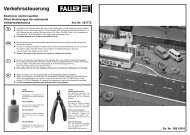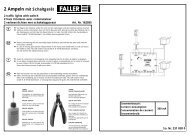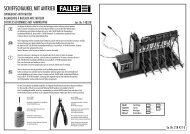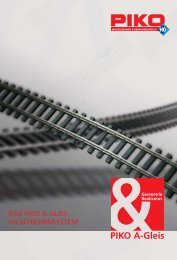INSTRUCTION MANUAL
INSTRUCTION MANUAL
INSTRUCTION MANUAL
You also want an ePaper? Increase the reach of your titles
YUMPU automatically turns print PDFs into web optimized ePapers that Google loves.
Decoder MX620 - MX622, MX630 - MX632 Sound Decoder MX640 - MX648 Page 41<br />
CV Table for SOUND CONFIGURATIONS:<br />
The following CV’s can be programmed both “normal” (i.e. CV #... = ...) and “incremental” (Exception:<br />
CV #280 for diesel engines). “Incremental programming” is especially useful when the proper<br />
value cannot be calculated in advance and must be determined by trial, which is often the case<br />
with many sound parameters.<br />
The “Lead CV” in each case is the first of 3 consequential CV’s that are edited and shown on the<br />
same screen of a ZIMO MX31 cab during the “incremental programming” procedure..<br />
CV Designation Range<br />
LEIT<br />
- CV<br />
#266<br />
#267<br />
#268<br />
LEAD<br />
- CV<br />
#269<br />
# 270<br />
Total volume<br />
Chuff sound frequency<br />
with „virtual<br />
cam sensor“<br />
for STEAM engines<br />
also see CV #354<br />
Switching to real<br />
cam sensor<br />
and<br />
trigger count for chuff<br />
rate<br />
for STEAM engines<br />
Lead-chuff<br />
accentuated<br />
for STEAM engines<br />
PROJEKT<br />
not functional yet:<br />
Longer chuff length<br />
at very low speeds<br />
for STEAM engines<br />
INCstep<br />
Default<br />
0 - 255 5 65<br />
0 - 255 1 70<br />
0 - 255 1 0<br />
0 - 255 10 0<br />
0 - 255 10 ?<br />
Description<br />
The value “65” results (mathematically) in the<br />
highest possible distortion-free playback volume;<br />
but values of up to 100 can be perfectly suitable<br />
because distortions in this volume range are hardly<br />
audible. Plus, the usefulness of a sound also<br />
depends on the quality of the sound sample.<br />
CV #267 is only active if CV #268 = 0:<br />
Chuff beats follow the “virtual cam sensor”; an actual<br />
cam sensor is not needed in this case.<br />
The default setting “70” results in about 4, 6 or 8<br />
chuffs per wheel revolution, depending on the<br />
chuff set selected; because it also depends in<br />
large part on the motor and gearbox used, an individual<br />
adjustment is necessary in most cases in<br />
order to achieve the exact chuff frequency. This is<br />
the purpose for CV #267:<br />
The lower the value the higher the chuff frequency<br />
and vice versa. The setting should be performed<br />
at a low speed (around speed step 10), but not at<br />
the lowest speed step 1.<br />
= 0: “Virtual“ cam sensor is active (to be adjusted<br />
with CV #267, see above).<br />
= 1: real cam sensor is active (connected to<br />
switch input 2 of the MX640, see chapter 6);<br />
each negative spike results in a chuff beat.<br />
= 2, 3, 4 … real cam sensor, several triggers in<br />
sequence (2, 3, 4 …) result in one chuff beat.<br />
A typical sound signature of a passing steam engine<br />
is that one chuff out of a group of 4 or 6<br />
chuffs is louder in volume than the rest; this effect<br />
is already part of the chuff set but can be further<br />
amplified with the help of CV #269.<br />
PROJECT (not yet implemented):<br />
The chuff sounds of a real engine are extended<br />
when driving at very low speeds due to the mechanical<br />
valve control. This effect can be more or<br />
less accentuated with CV #270.<br />
CV Designation Range<br />
#271<br />
LEIT<br />
- CV<br />
#272<br />
#273<br />
#274<br />
Overlapping effect at<br />
high speed<br />
for STEAM engines<br />
Blow-off duration<br />
for STEAM engines<br />
Start-up delay<br />
during blow-off<br />
for STEAM engines<br />
Blow-off schedule<br />
for STEAM engines<br />
0 – 255<br />
(useful<br />
up to @<br />
30)<br />
0 - 255<br />
=<br />
0 - 25 sec<br />
0 - 255<br />
=<br />
0 - 25 sec<br />
0 - 255<br />
=<br />
0 - 25 sec<br />
INCstep<br />
Default<br />
1 16<br />
10<br />
50<br />
=<br />
5 sec<br />
1 0<br />
10 30<br />
Description<br />
The individual steam chuffs overlap each other at<br />
high speed on a real engine. Because the frequency<br />
of the chuffs increases but won’t shorten<br />
to the same extend they will eventually blend in to<br />
a weakly modulated swoosh.<br />
This is not always desired in model railroading<br />
because it doesn’t sound that attractive, hence CV<br />
#271, with which an adjustment is possible to<br />
have the chuff beats accentuated at high speed or<br />
rather fade away.<br />
Opening the cylinder valves on a prototype steam<br />
engine for the purpose of water drainage is entirely<br />
up to the engineer. An automated draining at<br />
start-up is more suitable in model railroading; CV<br />
#272 defines how long after start-up the blow-off<br />
sound should play.<br />
Value in CV #272 = time in tenth of a second!<br />
Note: If the blow-off sound is also allocated to a<br />
function key (as delivered on F4, see CV #312),<br />
the automated blow-off sound can be shortened<br />
or extended with the relevant function key. Automated<br />
blow-off and function blow-off are inevitably<br />
the same (per selection/allocation).<br />
= 0: no blow-off sound played back<br />
Opening the cylinder valves and with it the related<br />
blow-off sound on a real steam engine starts most<br />
often before the engine even starts to move.<br />
This can be imitated with CV #273 by automatically<br />
delaying the start.<br />
This effect is cancelled when a shunting function<br />
with momentum deactivation is being activated<br />
(see allocation of F3 or F4 in CV #124!)<br />
= 0: no start delay<br />
= 1: Special setting for blow-off via speed<br />
regulator; no start-up delay but setting the<br />
speed to the lowest speed step initiates the<br />
blow-off sound only without starting the motor<br />
(only with 128 speed steps).<br />
= 2: Start-up delay in tenths of a second,<br />
Recommendation: no value > 20 (> 2 sec)<br />
During shunting operations that often requires<br />
many short trips with associated idle times, opening<br />
and closing the cylinder valves every time is<br />
not usually done. CV #274 causes the blow-off<br />
sound to be suppressed if the engine wasn’t<br />
standing still for the time defined here.<br />
Value in CV #274 = time in tenth of a second!<br />
Note: Shunting with permanently open cylinder<br />
valves can be achieved by actuating the function










